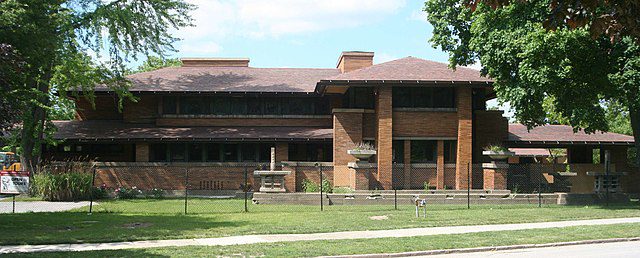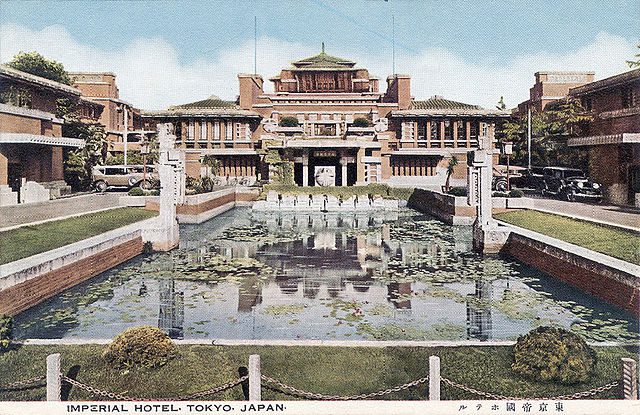
Frank Lloyd Wright, born on June 8, 1867, in Richland Center, Wisconsin, was an architect of profound influence, whose designs and ideas heralded new thinking in architecture. His work embraced the belief that buildings should harmonize with humanity and the environment, a philosophy he called organic architecture. Wright’s innovative designs, dedication to organic architecture, and personal life, marked by as much controversy as acclaim, shaped his legacy as one of the most iconic figures in architecture.
Wright’s early years were formative in developing his unique architectural vision. His mother, Anna Lloyd Jones Wright, instilled in him a love of architecture, famously placing engravings of European cathedrals in his nursery. Wright’s father, William Cary Wright, was a preacher and a musician. The family moved frequently during Wright’s childhood, which exposed him to a variety of architectural styles and natural settings. These experiences sowed the seeds of Wright’s lifelong belief in designing structures that were in harmony with humanity and their environment.

In 1887, Wright moved to Chicago, the city that would become the canvas for many of his early works. He began his architectural career as a draftsman in the firm of Joseph Lyman Silsbee, where he worked on the Unity Chapel, among other projects. Eager for more challenging work, Wright soon joined the firm of Adler & Sullivan, working directly under Louis Sullivan, whom he referred to as “Lieber Meister” (dear master). Sullivan’s influence on Wright was profound, instilling in him the belief that form follows function, a principle that would underpin much of Wright’s later work.
Striking Out
Wright’s independent career began around 1893 when he left Adler & Sullivan to open his own Chicago practice. His early work included the Winslow House (1893) in River Forest, Illinois, which showcased his departure from traditional architectural forms. Wright’s designs from this period laid the groundwork for what would become known as the Prairie School of architecture, characterized by horizontal lines, flat or hipped roofs with broad overhanging eaves, windows grouped in horizontal bands, integration with the landscape, and a strong sense of horizontality and harmony with the earth.
Perhaps Wright’s most famous work from his Prairie period is the Robie House (1909) in Chicago, Illinois. This residence epitomized the Prairie style and is often considered one of the most important buildings in American architecture. Wright’s use of open floor plans, innovative construction techniques, and attention to interior design details were revolutionary at the time and influenced the direction of modern architecture.

In 1935, Wright began work on what is arguably his most famous project, Fallingwater, for the Kaufmann family in rural Pennsylvania. Cantilevered over a waterfall, Fallingwater exemplifies Wright’s principle of organic architecture, integrating the house with the site so seamlessly that the natural and man-made elements become indistinguishable. This masterpiece cemented Wright’s reputation as a pioneer of a uniquely American style of architecture that was in dialogue with the natural world.
Another cornerstone of Wright’s architectural legacy is the Solomon R. Guggenheim Museum in New York City, completed posthumously in 1959. Its unique spiral design marked a radical departure from traditional museum layouts and remains one of the most significant architectural icons of the 20th century.
The Educator
Throughout his career, Wright was also a prolific writer and educator. He founded the Taliesin Fellowship in 1932, a community of apprentices who lived and worked with Wright, contributing to both his architectural projects and agricultural endeavors. This initiative reflected Wright’s belief in the importance of hands-on experience in education and his desire to mentor the next generation of architects.
Wright’s personal life was as unconventional as his architecture. He experienced significant personal and financial turmoil, including a scandalous affair with Mamah Borthwick Cheney, which led to his social ostracization, and the tragic murder of Cheney and six others at his Taliesin estate in 1914. Despite these challenges, Wright’s professional output remained prolific, and he continued to innovate and push the boundaries of architecture until his death on April 9, 1959.

Frank Lloyd Wright’s legacy is not just in the buildings he designed but in his contribution to the philosophy of architecture. His emphasis on organic architecture, his innovative use of materials and technology, and his approach to space and light continue to influence architects and designers. Wright believed that architecture could improve lives and bring harmony between humanity and the environment. His work, spanning over 70 years, produced more than 1,000 designs, of which over 500 were realized. These structures and Wright’s underlying architectural philosophy remain relevant, inspiring generations to rethink their environments and the spaces they inhabit.




